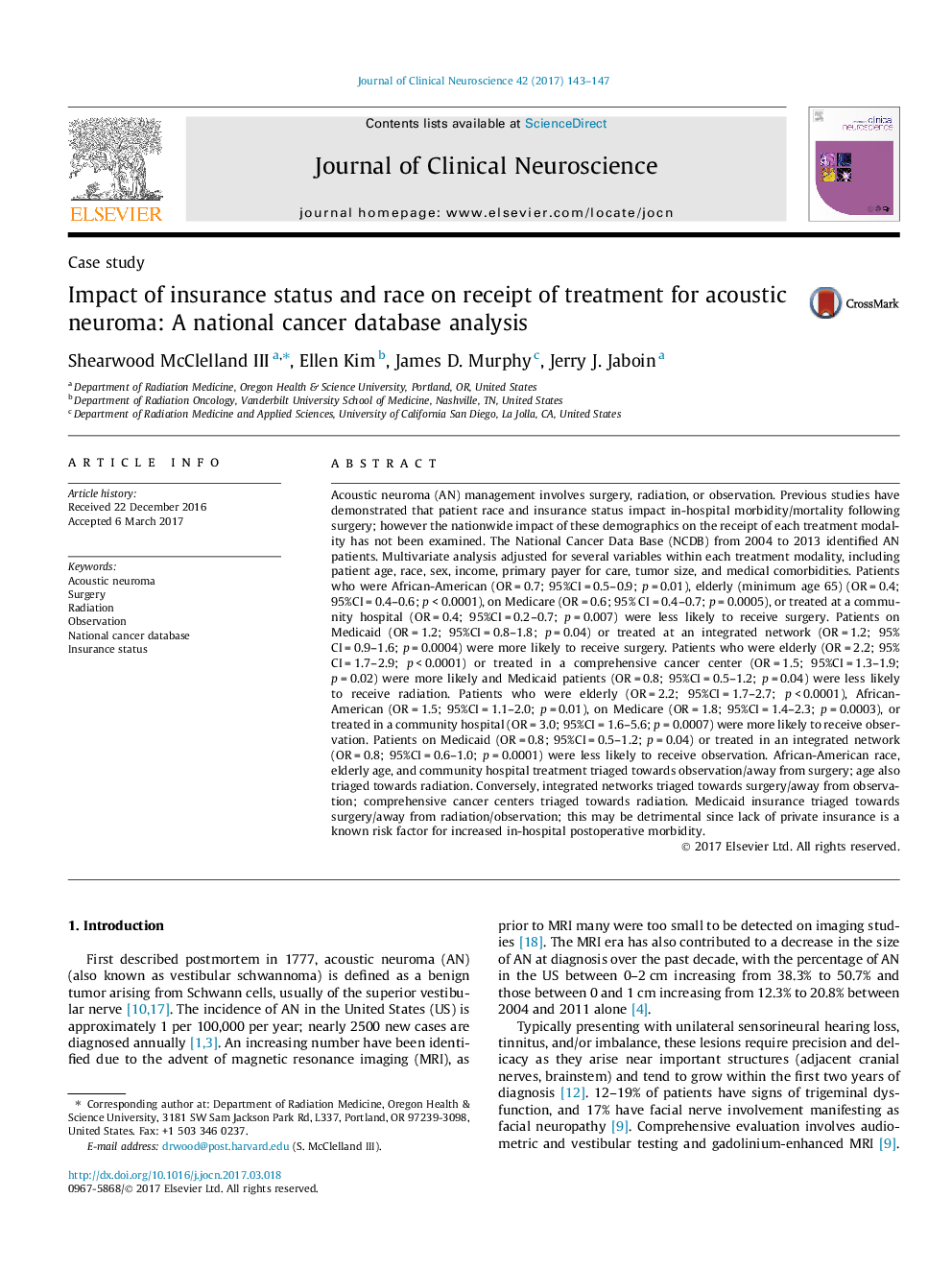| کد مقاله | کد نشریه | سال انتشار | مقاله انگلیسی | نسخه تمام متن |
|---|---|---|---|---|
| 5629760 | 1580274 | 2017 | 5 صفحه PDF | دانلود رایگان |

- African-American race triaged from surgery towards acoustic neuroma observation.
- Elderly age triaged from surgery towards acoustic neuroma radiation or observation.
- Integrated networks triaged towards surgery and away from observation.
- Comprehensive cancer centers triaged towards radiation for acoustic neuroma.
- Medicaid insurance triaged towards surgery and away from radiation/observation.
Acoustic neuroma (AN) management involves surgery, radiation, or observation. Previous studies have demonstrated that patient race and insurance status impact in-hospital morbidity/mortality following surgery; however the nationwide impact of these demographics on the receipt of each treatment modality has not been examined. The National Cancer Data Base (NCDB) from 2004 to 2013 identified AN patients. Multivariate analysis adjusted for several variables within each treatment modality, including patient age, race, sex, income, primary payer for care, tumor size, and medical comorbidities. Patients who were African-American (OR = 0.7; 95%CI = 0.5-0.9; p = 0.01), elderly (minimum age 65) (OR = 0.4; 95%CI = 0.4-0.6; p < 0.0001), on Medicare (OR = 0.6; 95% CI = 0.4-0.7; p = 0.0005), or treated at a community hospital (OR = 0.4; 95%CI = 0.2-0.7; p = 0.007) were less likely to receive surgery. Patients on Medicaid (OR = 1.2; 95%CI = 0.8-1.8; p = 0.04) or treated at an integrated network (OR = 1.2; 95%CI = 0.9-1.6; p = 0.0004) were more likely to receive surgery. Patients who were elderly (OR = 2.2; 95%CI = 1.7-2.9; p < 0.0001) or treated in a comprehensive cancer center (OR = 1.5; 95%CI = 1.3-1.9; p = 0.02) were more likely and Medicaid patients (OR = 0.8; 95%CI = 0.5-1.2; p = 0.04) were less likely to receive radiation. Patients who were elderly (OR = 2.2; 95%CI = 1.7-2.7; p < 0.0001), African-American (OR = 1.5; 95%CI = 1.1-2.0; p = 0.01), on Medicare (OR = 1.8; 95%CI = 1.4-2.3; p = 0.0003), or treated in a community hospital (OR = 3.0; 95%CI = 1.6-5.6; p = 0.0007) were more likely to receive observation. Patients on Medicaid (OR = 0.8; 95%CI = 0.5-1.2; p = 0.04) or treated in an integrated network (OR = 0.8; 95%CI = 0.6-1.0; p = 0.0001) were less likely to receive observation. African-American race, elderly age, and community hospital treatment triaged towards observation/away from surgery; age also triaged towards radiation. Conversely, integrated networks triaged towards surgery/away from observation; comprehensive cancer centers triaged towards radiation. Medicaid insurance triaged towards surgery/away from radiation/observation; this may be detrimental since lack of private insurance is a known risk factor for increased in-hospital postoperative morbidity.
Journal: Journal of Clinical Neuroscience - Volume 42, August 2017, Pages 143-147